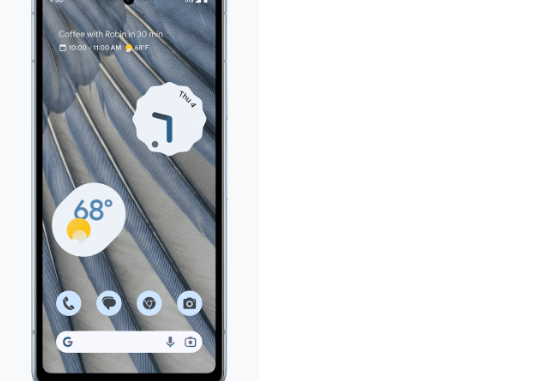
You know that adage, “you get what you pay for.” Well, it’s not always true. With Google’s new Pixel 7A phone, you get more than you pay for, compared with other phones.
At $499, the 6.1-inch Pixel 7A is $100 less than the 6.3-inch Pixel 7 and $400 less than the 6.7-inch Pixel Pro. In terms of screen size, the 7A is more than big enough. It fits in my hand better than the 7 and the 7 Pro. The 7A is bigger and a lot less expensive than the iPhone 14, which starts at $799. It’s also less expensive than most Samsung phones. Size is only one of several things to consider when buying a phone, but larger phones typically cost more than smaller ones.
Android vs. iOS
There are people who dismiss Android phones, because they are wedded to iOS and the Apple eco-system. I get it. Apple does a great job integrating its products, making it easy to go back and forth among their phones, laptops, watches and tablets. But Google is starting to create its own eco-system with its Pixel watch, Fitbit trackers, Nest hubs and the recently announced Pixel Tablet. Samsung also has a suite of products designed to keep its customers loyal, but truth be told, it’s not that hard to switch between products from these companies. With the exception of Apple’s own apps, there are Android versions of most iOS apps.
I prefer Pixels to other Android phones, because the interface is typically less cluttered, and they are always up-to-date with the latest Android operating systems. Other Android phone makers often delay updates and sometimes never fully update their devices to the latest version of Android. One of my favorite Pixel features is the camera’s Magic Eraser that makes it easy to remove objects in photos, often without affecting the background.
My current phone is the larger 6.7-inch Pixel Pro, which sells for $899, but as I explain later on, it cost me a lot less because of a trade-in.
A lot like the Pixel 7
When you compare the 7A with its more expensive counterpart, the differences are close to nil. It’s definitely the best value when it comes to Google phones and arguably when compared with the competition.
The 7A is a tiny bit smaller, but has the same chipset, the same amount of memory and storage at 128 GB (though the 7 has the option or 256 GB), a slightly higher resolution rear camera, a slightly higher capacity battery and the same wireless charging. Like the 7, it’s also water resistant. When it comes to storage, 128 GB is plenty unless you’re storing video or a lot of photos. I have plenty of apps and photos on my phone but am only using 84 GB of storage. You can compare the tech specs of the 7A, 7 and 7Pro at tinyurl.com/pixelcompare.
Both the 7A and 7 look the same and have the same power and volume and buttons, speakers, USB-C ports and SIM card slots. The 7 has a slightly brighter screen, but you’d be hard-pressed to see the difference.
The 7A has a plastic back rather than the glass used on the 7, but most people put their phone in a case or bumper, so that’s basically irrelevant. The 7 also has slightly better water resistance and slightly more durable gorilla glass, but these differences are pretty minuscule.
Because they use the same chips, performance is the same.
Folding phones
I still haven’t had the opportunity to review the new Pixel Fold, but I did get a little hands-on time with it the day it was unveiled. It’s an impressive piece of engineering, but starting at $1,799, it’s not something I would recommend for most people. When folded, the phone has a 5.8-inch display that looks like other Pixel phones though slightly thicker, though Google says it’s the thinnest folding phone on the market. Unfolded, it turns into a 7.6-inch tablet with the added advantage of being able to see different displays on the two halves of the screen and the ability to show one half of the screen to another person while you look at your half. It also makes framing selfies easier. You can unfold the phone to frame yourself with the front display and take the picture with the higher-resolution rear camera. All that is cool, but again, it comes at a price. Eventually, I suspect foldable phones will get cheaper and that might make them a mainstream item.
If I were to buy a folding phone, I’d be tempted by the Samsung Galaxy z Flip, which doesn’t pretend to be a tablet but pays homage to the flip phones of yesteryear by folding into a pocketsize phone and unfolding to a full 6.7-inch phone.
Check for subsidies
When shopping for a phone, check with your carrier to see if they’re offering any subsidies or trade-in offers. You might be able to get a $1,000 phone for as little as $200 or possibly even free. These offers usually come with a long-term contract, but if you’re happy with your carrier, it might make sense. By trading in an old phone, I got my $899 Pixel 7 Pro from AT&T for about $200, which made that higher price tag irrelevant.